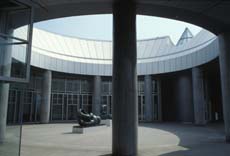index
What place grammars don't do
The grammar of a place is not the same as the program or the style of buildings in that place. Sometimes the grammar of the place can be more enduring than a building. Imagine a legislative body that rebuilds its meeting place in a new style but does not change its norms of operation or the way it divides its assembly room among the parties. More often the building endures while the place grammar changes. The Pantheon in Rome has had different place identities, as a temple, a church, a museum, and a tourist attraction. However, social grammar is not in total control. The Pantheon's authoritative design obviously has had tremendous influence on whatever grammars it acquired. Architectural and spatial effects can occur quite independently of place grammar. The Pantheon brings to bear on its current identity powerful spatial and geometric experiences with cosmological and historical associations that transcend any current norms for what goes on in the place. Buildings are not neutral containers for place grammars, and their architectural effects may or may not be consonant with the grammar of the place. Sometimes the social grammar will ignore or go against the architecture of the place, as may happen when a new institution is founded in an older building, for instance a democratic assembly in a former royal palace.

